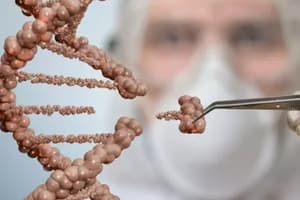Podcast
Questions and Answers
What are the sex chromosomes in humans?
What are the sex chromosomes in humans?
X and Y chromosomes
Which sex chromosome influences the immature gonads to become testis?
Which sex chromosome influences the immature gonads to become testis?
Y chromosome
Who developed the Lyon hypothesis?
Who developed the Lyon hypothesis?
- Dr. Mary Lyon (correct)
- Susumo Ohno
- XIST
- Tiepolo and Zuffardi
What is the mechanism of dosage compensation in females?
What is the mechanism of dosage compensation in females?
What happens to a female's X chromosome after it is inactivated?
What happens to a female's X chromosome after it is inactivated?
What is Turner Syndrome?
What is Turner Syndrome?
What is another term for 47,XXX?
What is another term for 47,XXX?
What causes hypogonadism and infertility in males?
What causes hypogonadism and infertility in males?
What is the extra chromosome in 47,XYY?
What is the extra chromosome in 47,XYY?
Structural abnormalities of sex chromosomes are common.
Structural abnormalities of sex chromosomes are common.
What is an isochromosome?
What is an isochromosome?
Flashcards are hidden until you start studying
Study Notes
Sex Determination and Chromosomes
- Sex chromosomes are the last pair of human chromosomes, designated as X and Y.
- Humans typically have 23 pairs of chromosomes; females have two X chromosomes (XX) while males have one X and one Y (XY).
- Genetic sex is established at fertilization, depending on whether an X or Y sperm fertilizes an X-bearing egg.
Sexual Differentiation
- Gonads appear identical before the seventh week of embryonic life.
- The presence of the Y chromosome drives differentiation of the gonad into testes, while the absence leads to ovary formation.
- Pseudoautosomal regions (PAR1 and PAR2) on X and Y chromosomes are crucial for normal meiotic crossing-over.
X Chromosome Inactivation
- The Lyon hypothesis states that one X chromosome in females is randomly inactivated, creating Barr bodies.
- X inactivation ensures equal gene dosage between males (one X) and females (one active X).
- XIST (X-inactive specific transcript) is the gene responsible for X inactivation and is expressed only from the inactive X chromosome.
Y Chromosome Characteristics
- Composed of pseudoautosomal regions, heterochromatic regions, and Male Specific Region of the Y (MSY).
- MSY contains protein-coding genes and plays a crucial role in male fertility.
- The SRY gene (Sex-determining Region Y) initiates male gonad differentiation.
Sex Chromosome Abnormalities
- Abnormalities can be numerical (aneuploidy) or structural.
- Common numerical abnormalities include Turner Syndrome (45,X) affecting female development and Klinefelter Syndrome (47,XXY) influencing males.
- Turner Syndrome occurs in approximately 1 in 2,500 live-born females, often leading to features like short stature and ovarian failure.
Turner Syndrome (45,X)
- Characterized by clinical features such as webbed neck, posteriorly rotated ears, and edema.
- Increased risks of developmental delays, feeding difficulties, and visual-spatial skill issues.
- Majority of cases have a maternal origin for the missing X chromosome.
Trisomy X (47,XXX)
- The most common sex chromosome disorder in females, occurring in about 1 in 1,000 live births.
- Often undetected; pubertal development is normal with variable ovarian function.
- Linked to risks of learning disabilities and lower IQ compared to siblings.
Klinefelter Syndrome (47,XXY)
- First identified sex chromosome disorder; common cause of infertility in males.
- Features include tall stature, small testes, and possible gynecomastia.
- Developmental concerns include language delays and learning difficulties.
Additional Y Chromosome Variants
- The 47,XYY karyotype occurs once in every 800-1,000 males; features include taller stature and a higher rate of learning disabilities.
- Variants with additional X or Y chromosomes can affect fertility and developmental patterns.
Structural Abnormalities
- Isochromosome Xq often seen in Turner syndrome contributes to fertility issues.
- Structural abnormalities can include deletions and duplications and may increase the risk of conditions like gonadoblastoma.
Summary
- Sex determination relies on the X and Y chromosomes, where the Y chromosome drives male differentiation.
- Chromosomal aberrations can lead to distinct syndromes with varied clinical implications, impacting growth, development, and fertility.
- Research in genetic mechanisms continues to reveal complexities in sex chromosome roles and disorders.
Studying That Suits You
Use AI to generate personalized quizzes and flashcards to suit your learning preferences.




